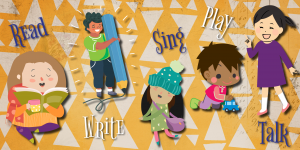While I write this post, we are in the midst of the 2020 coronavirus pandemic. As we find ourselves more indoors than ever, it is important to note that if we are able to go outside safely, that we are practicing social distancing and masking up. Children under age 2 should not wear a mask.
 Early literacy learning doesn’t only happen inside. Outdoor spaces provide an opportunity for children to practice literacy skills in an engaging and fun environment. Outdoor spaces include backyards, parks, camping and hiking areas, neighborhoods, alleyways, front porches, and community gardens; basically anywhere outside of a building. When we take learning outside, children are able to move their bodies and approach problems from a fresh perspective. Sometimes simply being outside helps the brain open up.
Early literacy learning doesn’t only happen inside. Outdoor spaces provide an opportunity for children to practice literacy skills in an engaging and fun environment. Outdoor spaces include backyards, parks, camping and hiking areas, neighborhoods, alleyways, front porches, and community gardens; basically anywhere outside of a building. When we take learning outside, children are able to move their bodies and approach problems from a fresh perspective. Sometimes simply being outside helps the brain open up.
There are many opportunities to help children develop their writing skills while in outside spaces. For example, helping hang clothes on a clothesline is an excellent way to practice the “pincer” grip, which is the first step in grasping writing tools. Another example is encouraging children to crawl, jump, or swim which helps the core muscles develop which makes it easier to sit tall and upright while writing.
It’s best for children to develop writing skills slowly by focusing on one skill after another. Once one skill is mastered, we move onto the next. We call this “scaffolding” and it’s an important method that not only makes success more manageable, but gives children smaller victories along the way that build their confidence. Here is an excellent visual guide on the steps children take on their journey to writing.
 Babies
Babies
- Playing in the dirt with their fingers helps babies build strong muscles necessary for holding writing tools.
- Water and a paintbrush provides a wonderful activity that is mess free! This is really fun on smooth rocks.
- Chunky writing tools, like sidewalk chalk, make practicing scribbling (early writing) more manageable for children. Hopscotch, anyone?
- Talk with your child about seeing shapes in nature and let children touch them. Shapes are the first step to writing!
Toddlers and Preschoolers
- Building letters or words out of rocks or sticks is a great way to think about the shapes in each letter.
- Through pretend play, children can begin to understand the importance and meaning of text.
- Taking orders
- Making lists
- Creating business signs (lemonade!) and posters
- Labeling maps
For more information on writing development, visit Zero to Three: Learning to Write and Draw.
-Taylor, Children's Librarian, Quincie Douglas Library
 Read, Write, Talk, Sing, Play!
Read, Write, Talk, Sing, Play!
When children are given a chance to explore scribbling, draw pictures, and tell stories, they are learning reading skills. Being an active participant in writing helps keep children excited about reading stories.
Read more about early literacy and how you can make a difference in your child's life.


